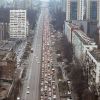Recognising fake news
Putin’s war against Ukraine is also being fought in the newsroom. Discover here how to verify the news.

“The first casualty when war comes, is truth”, US Senator Hiram Johnson said during the First World War in 1917. At the time, there were only newspapers and no radio, let alone television.
In Putin’s war against Ukraine a major role is being played by fake news, some of it being used specifically for propaganda purposes. So how can fake news be recognised in this era of internet and social media? The first step of course is to be very cautious when spreading news – before doing so you should always subject it to a three-step check.
Check the sources and origin of the news
Look at who is spreading the news! Is there a website with full credits and a physical, verifiable address? Is the news being published by an editor or editorial team that you can check? If not, or if you receive the news via Messenger, then it is often worth using a search engine to hunt for the exact wording of the text. This may well reveal the origins of the text itself, as well as any fact checks that may already have been conducted.
Check the facts and make sure they are logical and make sense
You can check some facts yourself: in one alleged video showing the war against Ukraine, the leaves on the trees are green – that cannot be the case in winter. The video is obvious faked, in other words. In many cases, however, individuals are unable to carry out such checks. But there are reliable fact checkers whose websites you can visit to find out more. In Germany, these include for example the public-service broadcasters ARD and Bayrischer Rundfunk and Deutsche Welle.
Research the origins of images and videos yourself
Fake news often show images or videos taken from an entirely different context; in the Ukraine war, some are even taken from computer games. Powerful online tools can help you if you wish to verify images or videos yourself. Using the reverse image search from Google, it is frequently possible to find out whether the image in question has already been uploaded before – and in which context.
This check is more difficult in the case of videos, though here too you can use screenshots to attempt a reverse image search. The YouTube Data Viewer from Amnesty International can be very helpful in this context.
Is there fake news in German media?
Falsified reports are always possible, and German media have also been deceived by fake news in the past. All German media are subject to the press code, however; it lays down guidelines for journalistic work. Among many other principles, it states for example that “information in word, picture and graphics must be carefully checked in respect of accuracy in the light of existing circumstances. (…) Unconfirmed reports, rumours or assumptions must be quoted as such.” If individual media, be it a newspaper, TV or radio, violate this code, anyone can file a formal complaint with the German Press Council.


